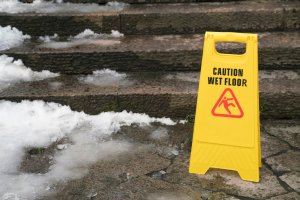Slip and Falls Loss Prevention
Slip and Fall Loss Prevention
Anyone on common property should not be subjected to unexpected hazards.
Your Legal Liability
Condominium Corporations need to understand their legal responsibilities as the owner or occupier of the common areas. An occupier is anyone that has physical control of the premises, including the conditions and the activities carried on there.
The Occupiers Liability Act states that the board has to take reasonable care to ensure that people are safe while on your premises (common property).
If a visitor, or a unit owner, slips, trips, falls and is injured on your common property, legal action could be brought against the corporation.
What is Reasonable Care?
Some examples of criteria include:
Whether the danger was foreseeable.
Example: It is conceivable that a narrow, dimly lit staircase could pose a hazard.
Whether a hazard was allowed to exist for an extended period of time.
Example: Was the board notified of a potential hazard, and yet did nothing to eliminate it?
Whether a system of maintenance and inspection existed.
Example: Was there a property manager or board member in charge of ensuring premises are safe and are there logbooks?
Whether the occupier acted in accordance with reasonably acceptable standards of practice.
Example: An occupier might not be expected to clear his premises of snow and ice every half an hour, but is waiting a week after a snow storm acceptable? Most likely not.
Potentially Dangerous Conditions
- Ice/snow that has not been cleared
- Slippery floors (spills, wet floors)
- Inadequate lighting conditions
- Missing or loose handrails on stairs
- Holes, gaps or cracks in flooring
- Sudden changes in elevation (unexpected bumps, curbs, potholes)
- Debris such as slippery and wet fall leaves
- Amenity rooms including gyms, pools and saunas
Address Potential Slip And Fall Hazards
Interior
- Repair or replace loose flooring materials
- Use non-slip flooring materials or treatments to make slippery floors safer
- Apply non-slip tapes to aid traction in critical areas such as stairs
- Lay down mats in locations where moisture accumulates
- Immediately mark spills (water or debris) with pylons or wet floor signs, and clean promptly
Exterior
- Stairs and handrails must comply with building code requirements
- Install adequate lighting in all areas
- Special visible markings may be needed on curbs, speed bumps and pedestrian walkways
- Clear and repair damaged pavement, walkways or steps
- Check for areas of uneven pavement, potholes or unexpected steps, unmarked trip points, obstacles or debris
Additional Precautions For Winter Conditions
- Pay close attention to procedures and local by-laws for clearing and salting of walkways and parking lots during the winter.
- Contracts for snow removal or winter maintenance (i.e. sanding and salting) must clearly identify the responsibilities of each party. The responsibility to start snow removal or other maintenance must be clearly understood and documented. The criteria that trigger maintenance and the responsibility for detailed record keeping should be noted in the contract.
- Any insurance clauses or hold harmless agreements need to be understood and should be reviewed by your insurance broker or lawyer.
- Stipulate that snow logs are maintained. Snow logs verify when clearing or maintenance took place (including start and completion), where, what was done, weather conditions, who performed the task and any comments. Snow logs are vital if there is a slip and fall. They help prove due diligence, and not negligence.
What to do if Someone Slips, Trips Or Falls?
- Assist the injured person in finding medical treatment. Call an ambulance if necessary.
- Record the names and contact information of any witnesses. Obtain and note detailed descriptions of the incident from the injured party and witnesses.
- Refer any discussions with the claimant to the Corporation’s Insurer. Never admit liability.
- Take photographs of the area where the incident occurred. If possible, photograph the footwear that the injured person was wearing.
- Document the incident. This may help to establish a defense for a claim presented at a later date and help your insurer analyze the cause of the incident.
- Report the incident to the corporation’s insurer as soon as possible, with the information you have.
- Investigate potential causes and take steps to prevent and/or respond better to similar future incidents.
BFL’S REAL ESTATE TEAM UNDERSTANDS THE RISKS FACED BY CORPORATIONS.
In addition to protecting your investment, we offer guidance focused around claims prevention, coverage education and by-law review to property managers, landlords and condominium boards.
Report a New Claim During Regular Business Hours:
Toll Free: 1 866 669-9602
Fax: 1 604 683-9616

